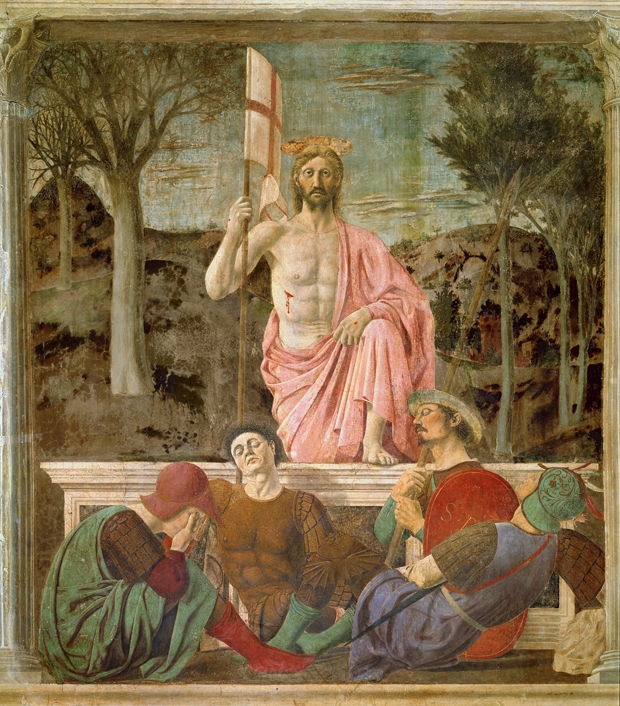It seems odd to enter a room dominated by what Aldous Huxley famously called ‘the greatest picture in the world’ to find not another soul there. Looking down from an end wall of the mediaeval civic hall in the quiet little Tuscan town of Borgo San Sepolcro, Piero della Francesca’s ‘Resurrection’ is an image of astonishing power, showing a stern-faced risen Christ stepping out of his tomb in the dawn light of the first Easter morning like an unstoppable force of nature, exuding supernatural authority as he turns the leaves on the trees behind him from wintry death to the new life of spring. This is a painting like no other in the history of art. But we can only still see it today thanks to the essay to which it inspired Huxley in 1925, ‘The Best Picture’.
When in 1964 H.V. Morton published A Traveller in Italy, he recalled a few years earlier meeting in Cape Town a second-hand bookseller, Anthony Clarke, who told him the remarkable story of how Huxley’s essay had prompted him to save this fresco from destruction. In 1944, as a British artillery captain, Clarke had been sent forward to the hills above San Sepolcro, supposedly full of Germans, with orders to blast the town to smithereens. Recalling its name from Huxley’s essay, in the nick of time he ordered his guns to stop firing. A young boy coming up the hill told them that the Germans had all left. Warily entering the town, Clarke, with huge relief, found Piero’s masterpiece untouched.
Last summer my family had two reasons for wanting to see all Piero’s paintings across Tuscany, by taking what is now known as ‘the Piero della Francesca trail’. One was that my son Nicholas had long shared my admiration for him as an artist like no other — the luminous nobility of his figures epitomising the Renaissance desire to portray humanity in its loftiest guise. His paintings are more subtly constructed than any others on mathematical lines: none more obviously than his ultimate puzzle picture, ‘The Flagellation’ in the Ducal Palace at Urbino: where three grave and exquisitely robed figures stand mysteriously in the foreground of a meticulously geometrical stage set, with Christ being flogged in the background.
Indeed, this was our second reason for wanting to take what Nick called ‘the PDF trail’, because Piero was in his day known not just as a painter but as a mathematician, playing a central part in that revolution which followed from the introduction to Europe of ‘Arabic’ numerals, which in fact originated from India. Nick is writing a book on India’s immense hidden contributions to western civilisation. One of the most important of these was the transformation brought about in European mathematics when the cumbersome old Roman numerals came to be replaced in the Middle Ages by the single-digit numerals from 0 to 10, adapted by the Arabs from Hindi originals.
The man who more than anyone codified these numerals, inventing the use of zero and the concept of negative numbers, was Brahma-gupta, a Rajasthani mathematician of the early 7th century. In 773, the second Abbasid caliph of Baghdad, Al-Mansur, summoned an international conference of astronomers and mathematicians, one of whom, Kankah, brought from India Brahmagupta’s chief treatise. Such an impact did this make on the assembled scholars that the caliph ordered it to be translated into Arabic, thus spreading use of the new numerals right across the Muslim world. It was from Algeria that, around 1200, the young Pisan mathematician Fibonacci brought them back to Italy (the famous ‘Fibonacci sequence’ he took directly from Brahmagupta).
However, it was not until the 15th century that the new numerals really caught on, in particular inspiring that interlinked group of multi-talented geniuses whose use of them to work out the scientific rules of perspective finally launched the Renaissance into overdrive. In Florence last summer we admired the architecture of Brunelleschi and Alberti and the frescoes of Masaccio, based on the eye-opening possibilities opened up by the ‘new maths’. But no one took them further than Piero, who became so preoccupied with the science of perspective and Euclidian geometry that his three treatises on mathematics made him as famous in his lifetime as his skill at painting.
This had come so to obsess him that, in the last 20 years of his long life, the imaginative fire of his art faded away, as he abandoned painting to concentrate on his mathematical researches. But their influence lived on, ironically, through one of his pupils in San Sepolcro, Friar Luca Pacioli, whose own most influential book, summarising the mathematical knowledge of his day, was shamelessly plagiarised from one by his master Piero. Because this, inter alia, set out all the principles of modern accounting, such as double-entry book-keeping, Pacioli has become known as ‘the father of accountancy’. But without Piero, or those Indian numerals, he couldn’t have done it, any more than he could have used the same principles to influence his friend Leonardo da Vinci in Milan in constructing what came to be looked on as one of the Renaissance’s supreme masterpieces, Leonardo’s ‘Last Supper’. It was not this, however, which Huxley hailed as the greatest picture in the world.






Comments